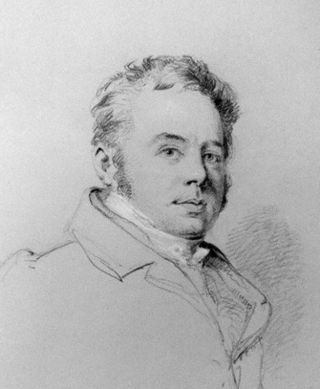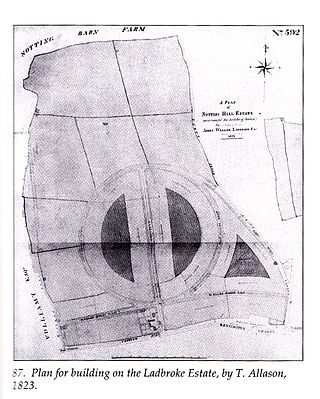
Notting Hill is a district of West London, England, in the Royal Borough of Kensington and Chelsea. Notting Hill is known for being a cosmopolitan and multicultural neighbourhood, hosting the annual Notting Hill Carnival and the Portobello Road Market. From around 1870, Notting Hill had an association with artists.

James Brownlow William Gascoyne-Cecil, 2nd Marquess of Salisbury,, styled Viscount Cranborne until 1823, was a British Conservative politician. He held office under the Earl of Derby as Lord Privy Seal in 1852 and Lord President of the Council between 1858 and 1859. He was the father of Robert Gascoyne-Cecil, 3rd Marquess of Salisbury, three times Prime Minister of the United Kingdom, and grandfather of Arthur Balfour, who also served as Prime Minister.

Ladbroke Grove is a road in the Royal Borough of Kensington and Chelsea, London, England, which passes through Kensal Green and Notting Hill, running north–south between Harrow Road and Holland Park Avenue.

Notting Hill Gate is one of the main thoroughfares in the Royal Borough of Kensington and Chelsea. Historically the street was a location for toll gates, from which it derives its modern name.

North Kensington is an area of west and northwest London. It is north of Notting Hill and south of Kensal Green predominately in the Royal Borough of Kensington and Chelsea and partly in the London Borough of Brent and City of Westminster. The names North Kensington and Ladbroke Grove describe the same area.

John Buonarotti Papworth was a British architect, artist and a founder member of the Royal Institute of British Architects.

Jacobus "James" Roosevelt III was an American businessman and politician from New York City. A member of the Roosevelt family, he was the son of Isaac Roosevelt and great-grandfather of President Franklin D. Roosevelt.

St John's Notting Hill is a Victorian Anglican church built in 1845 in Lansdowne Crescent, Notting Hill, London, designed by the architects John Hargrave Stevens (1805/6–1857) and George Alexander (1810–1885), and built in the Victorian Gothic style. Dedicated to St John the Evangelist, the church was originally built as the centrepiece of the Ladbroke Estate, a mid nineteenth century housing development designed to attract upper- and upper middle-class residents to what was then a largely rural neighbourhood in the western suburbs of London.

The Kensington Hippodrome was a racecourse built in Notting Hill, London, in 1837, by entrepreneur John Whyte. Whyte leased 140 acres (0.57 km2) of land from James Weller Ladbroke, owner of the Ladbroke Estate, and proceeded to enclose "the slopes of Notting Hill and the meadows west of Westbourne Grove" with a 7-foot (2.1 m) high wooden paling. The race course was not a financial success and it closed in 1842, the land being developed soon afterwards, as Ladbroke began building crescents of houses on Whyte's former race course.

St Peter's Notting Hill is a Victorian Anglican church in Kensington Park Road, Notting Hill, London. Designed in the classical style by architect Thomas Allom, work was begun in 1855 and completed in 1857.

The Ladbroke Estate was a substantial estate of land owned by the Ladbroke family in Notting Hill, London, England, in the early 19th century that was gradually developed and turned into housing during the middle years of the century, as London expanded. Characterized by terraces of stuccoed brick houses backing onto large private garden squares, much of the original building remains intact today, and now forms the heart of one of London's most expensive and fashionable neighbourhoods.

Thomas Allason (1790–1852) was an English architect, surveyor and landscaper, noted in particular for his work at Connaught Square and the Ladbroke Estate in Kensington.

Arundel Gardens is a street and a communal garden square in Notting Hill, London, one of seven streets between Ladbroke Grove and Kensington Park Road of which five share in a communal garden between them. It was built in the 1860s, towards the later stages of the development of the Ladbroke Estate, until that decade part of the rural hinterland of London. Notable past residents of the street include psychologist Charles Samuel Myers, who coined the term shell shock, and the Nobel Prize-winning chemist Sir William Ramsay, discoverer of the noble gases.

Pottery Lane is a street in Notting Hill, west London. Today it forms part of one of London's most fashionable and expensive neighbourhoods, but in the mid-19th century it lay at the heart of a wretched and notorious slum known as the "Potteries and the Piggeries". The slum came to the attention of Londoners with the building of the Hippodrome in 1837 by entrepreneur John Whyte. Unfortunately for Whyte a public right of way existed over his land and "dirty and dissolute vagabonds" from the nearby slum invaded his racecourse, adding to his financial difficulties and, in part, leading to the closure of his venture in 1842. Pottery Lane gradually improved in the late 20th century along with the rest of the Notting Hill area, and today the houses there fetch multi-million pound prices. Just one of the original brick kilns still survives; it is located in Walmer Road, just north of Pottery Lane, and bears a commemorative plaque placed there by the Royal Borough of Kensington and Chelsea.

Ladbroke Square is a garden square in Notting Hill, west London, England.

Lancaster Road (West) Estate is a housing estate in North Kensington, west London.

Portland Road is a road in Notting Hill, in the Royal Borough of Kensington and Chelsea that was built as a speculative development in the 1850s. The road has been noted for its division into three sections of different wealth: the section between Holland Park Avenue and Clarendon Cross/Hippodrome Place being one of the most expensive places to buy a house in London, a section of terraced houses further north being also very expensive but less so than the lower reaches of the road, and a section at the northern end that was once slums and is now working class social housing and is described as being north of an "invisible line" that divides it from the privately owned sections of the road.
Charles Lawrence was a Liverpool merchant who served as Mayor of Liverpool in 1823–4. He is primarily remembered as Chairman of the Liverpool & Manchester Railway which opened in 1830.
Charles Henry Blake (1794–1872) was a British indigo planter and industrialist in India, who became a property developer and railway company director in London.



















